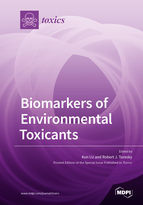Biomarkers of Environmental Toxicants
A special issue of Toxics (ISSN 2305-6304). This special issue belongs to the section "Exposome".
Deadline for manuscript submissions: closed (28 February 2019) | Viewed by 105370
Special Issue Editors
Interests: biomarker development; DNA adducts; metabolomics; proteomics; microbiome
Special Issue Information
Dear Colleagues,
Biomarkers are commonly used to evaluate exposure and biological effects of environmental toxicants. Characterization and development of sensitive and robust biomarkers have remained active over the last few decades to study the toxicity of environmental toxicants and human disease. There is a are clear need to further discover, validate and apply biomarkers in toxicological research, population-based studies, risk assessment and beyond. This Special Issue on “Biomarkers of Environmental Toxicants” will aim at highlighting the latest advances in biomarker-related research in a timely manner. Authors are invited to submit original research papers, reviews, and short communications.
Topics may include, but are not limited to, the following:
- Discovery or validation of new biomarkers of exposure and effects of environmental toxicants. These biomarkers could be DNA adducts, protein adducts, metabolites, enzymes, or any relevant biological molecules or indicators.
- Omics profiling, such as metabolomics and proteomics, to study the effects of environmental toxicants with the goal of developing potential biomarkers.
- Novel methods or assays for biomarker development.
- Development or analysis of compound- or organ-specific biomarkers.
- Development of microbiome as potential biomarkers.
- Characterization or measurement of biomarkers in human populations or selected cohorts.
Prof. Dr. Robert J. Turesky
Prof. Dr. Kun LU
Guest Editor
Manuscript Submission Information
Manuscripts should be submitted online at www.mdpi.com by registering and logging in to this website. Once you are registered, click here to go to the submission form. Manuscripts can be submitted until the deadline. All submissions that pass pre-check are peer-reviewed. Accepted papers will be published continuously in the journal (as soon as accepted) and will be listed together on the special issue website. Research articles, review articles as well as short communications are invited. For planned papers, a title and short abstract (about 100 words) can be sent to the Editorial Office for announcement on this website.
Submitted manuscripts should not have been published previously, nor be under consideration for publication elsewhere (except conference proceedings papers). All manuscripts are thoroughly refereed through a single-blind peer-review process. A guide for authors and other relevant information for submission of manuscripts is available on the Instructions for Authors page. Toxics is an international peer-reviewed open access monthly journal published by MDPI.
Please visit the Instructions for Authors page before submitting a manuscript. The Article Processing Charge (APC) for publication in this open access journal is 2600 CHF (Swiss Francs). Submitted papers should be well formatted and use good English. Authors may use MDPI's English editing service prior to publication or during author revisions.
Keywords
- biomarker
- environmental toxicants
- metabolomics
- proteomics
- method development
- microbiome
- population
- risk assessment








